Capiíbary | |
|---|---|
| Coordinates: 24°48′0″S56°2′24″W / 24.80000°S 56.04000°W | |
| Country | Paraguay |
| Department | San Pedro |
| Population (2008) | |
| • Total | 3 899 |
| Climate | Cfa |
Capiibary is a town in the San Pedro department of Paraguay.
Capiíbary | |
|---|---|
| Coordinates: 24°48′0″S56°2′24″W / 24.80000°S 56.04000°W | |
| Country | Paraguay |
| Department | San Pedro |
| Population (2008) | |
| • Total | 3 899 |
| Climate | Cfa |
Capiibary is a town in the San Pedro department of Paraguay.
The city gets its name from the Capiibary River, which was named Capiĭbarĭ (compound from capiĭbá·r "capybara" and ĭ "water, river") in Classical Guarani by the natives due to the abundance of these animals in the river. With time, the original pronunciation got mixed together with the Spanish reading of the name, thus producing the final form "Kapi'ivary," even in modern Guarani.

Paraguay, officially the Republic of Paraguay, is a landlocked country in South America. It is bordered by Argentina to the south and southwest, Brazil to the east and northeast, and Bolivia to the northwest. It has a population of around 6.1 million, nearly 2.3 million of whom live in the capital and largest city of Asunción, and its surrounding metro area.

Guaraní, specifically the primary variety known as Paraguayan Guarani, is a South American language that belongs to the Tupi–Guarani family of the Tupian languages. It is one of the official languages of Paraguay, where it is spoken by the majority of the population, and where half of the rural population are monolingual speakers of the language.
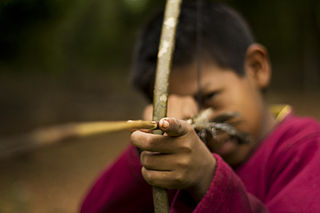
Guarani is a group of culturally-related indigenous peoples of South America. They are distinguished from the related Tupi by their use of the Guarani language. The traditional range of the Guarani people is in what is now Paraguay between the Paraná River and lower Paraguay River, the Misiones Province of Argentina, southern Brazil once as far east as Rio de Janeiro, and parts of Uruguay and Bolivia.
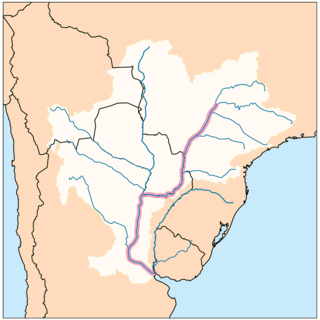
The Paraná River (Portuguese: Rio Paraná ; is a river in south-central South America, running through Brazil, Paraguay, and Argentina for some 4,880 kilometres. Among South American rivers, it is second in length only to the Amazon River. It merges with the Paraguay River and then farther downstream with the Uruguay River to form the Río de la Plata and empties into the Atlantic Ocean.
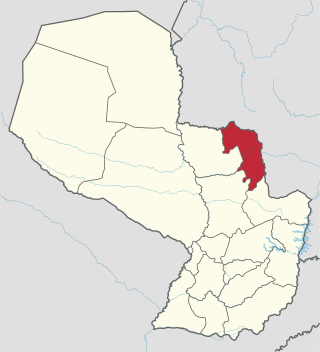
Amambay is a department in Paraguay. The capital is Pedro Juan Caballero.

Caazapá is a department in Paraguay. The capital is the city of Caazapá. Among Paraguayans, the department is well known for its orange and mandarin trees, and for its forest hills. The eastern part of Caazapá is relatively undeveloped and consists of rolling hills and large swaths of Brazilian Atlantic interior rainforest between the San Rafael mountains to the south and the Ybytyruzú mountains to the north. The western part is an area of low-lying marshes and swampland area, and consists of wetlands and tributaries to eastern Paraguay's largest river, the Tebicuary. Many indigenous groups make their home in what remains of the rainforest, especially south of the unpaved highway between San Juan Nepomuceno and Tavaí. Mby'a and Guayaki people, who practice farming corn, cassava and yerba mate under the canopy of the forest live in small bands and travel mainly by foot. They are technically protected and their land is a national reserve, but illegal loggers, ranchers, and more recently, Brazilian soybean growers have encroached upon their territory. With Paraguay's weak legal infrastructure, little can be done by way of enforcement or sanctions.
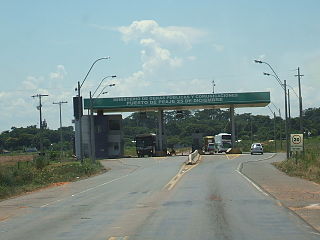
San Pedro is a department of Paraguay. The capital is the city of San Pedro de Ycuamandiyú.

The Gran Chaco or Dry Chaco is a sparsely populated, hot and semiarid lowland natural region of the Río de la Plata basin, divided among eastern Bolivia, western Paraguay, northern Argentina, and a portion of the Brazilian states of Mato Grosso and Mato Grosso do Sul, where it is connected with the Pantanal region. This land is sometimes called the Chaco Plain.
The guaraní is the national currency unit of Paraguay. The guaraní was divided into 100 céntimos but, because of inflation, céntimos are no longer in use.

Club Guaraní is a Paraguayan football team, based in the neighbourhood of Pinozá in outer Asunción. Founded on 12 October 1903, it is one of the oldest and one of the most successful in the country, with eleven Primera División titles, and has never been relegated to a lower division.
The Football Federation of the 2nd Department San Pedro is the departamental governing body of football (soccer) in the department of San Pedro, in Paraguay. The federation is responsible for the organization of football leagues in the different cities of the department and it is also the regulator of the clubs. The main office of this federation is located in the city of San Pedro.
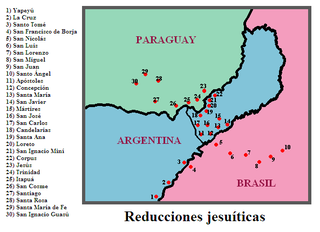
The Guaraní War of 1756, also called the War of the Seven Reductions, took place between the Guaraní tribes of seven Jesuit Missions and joint Spanish-Portuguese forces. It was a result of the 1750 Treaty of Madrid, which set a line of demarcation between Spanish and Portuguese colonial territory in South America.
Eastern Bolivian Guaraní, known locally as Chawuncu or Chiriguano (pejorative), is a Guaraní language spoken in South America. In Bolivia 33,670 speakers, called the Ava Guaraní people were counted in the year 2000, in the south-central Parapeti River area and in the city of Tarija. In Argentina, there were approximately 15,000 speakers, mostly in Jujuy, but also in Salta Province, and 304 counted in the Paraguayan Chaco.

Abaí is a district of Caazapá, Paraguay. It is the biggest district of the department and one of the country's biggest agricultural zones.
Jonathan Fabbro is an Argentine-born Paraguayan convicted felon and a former footballer who played as an attacking midfielder. In 2019, he was sentenced to fourteen years in jail for abuse of children.

Guayrá was a historical region of the Spanish Empire, located in the Governorate of Paraguay, within the colonial Viceroyalty of Peru. The region is located in present-day Paraguay and Paraná.

Aleixo Garcia, also known in Spanish as Alejo García, was a Portuguese explorer and conquistador in service to Spain. He was a castaway who lived in Brazil and explored Paraguay and Bolivia. On a raiding expedition with a Guaraní army, Garcia and a few colleagues were the first Europeans known to have come into contact with the Inca Empire.

Paraguayan Spanish is the set of dialects of the Spanish language spoken in Paraguay. In addition, it influences the speech of the Argentine provinces of Misiones, Corrientes, Formosa, and, to a lesser extent, Chaco. Paraguayan Spanish possesses marked characteristics of the Spanish previously spoken in northern Spain, because a majority of the first Spanish settlers were from Old Castile and the Basque Country. In addition, there is great influence, in both vocabulary and grammar, from the Guarani language. Guarani is co-official with Spanish in Paraguay, and most Paraguayans speak both languages. Guaraní is the home language of more than half the population of Paraguay, with higher proportions of its use in rural areas, and those who speak Spanish at home slightly in the majority in the cities. In addition to the strong influence of Guarani, Paraguayan Spanish is also influenced by Rioplatense Spanish due to the geographical, historical, and cultural proximity, as well as the sharing of features such as voseo, which is "the use of vos as a second-person singular pronoun." Paraguayan Spanish is notable for its lack of yeísmo, meaning that the phonemes /ʎ/ and /ʝ/ are distinguished.

The cuisine of Paraguay is the set of dishes and culinary techniques of Paraguay. It has a marked influence of the Guaraní people combined with the Spanish cuisine and other marked influences coming from the immigration received by bordering countries such as Italian cuisine and German cuisine. The city of Asunción is the epicenter of the distinctive gastronomy that extends in current Paraguay and its areas of influence, which is the reason why is considered the mother of the gastronomy of the Río de la Plata. It is worth clarifying that in the Paraguayan society, the exchange of knowledge between mestizos, creoles and cario-guaraní people occurred before the Jesuit missions.

The Mbyá, also called Mbyá Guaraní, are a branch of the Guaraní people who live in South America, across a wide territory that ranges through Paraguay, Brazil, Argentina, and Uruguay.